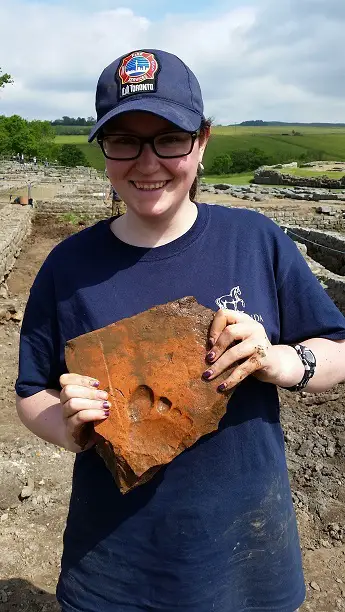Nowhere gets you closer to the Romans on Hadrian’s Wall than the fort and settlement of Vindolanda, the extraordinary hoard of personal artefacts gives you a unique insight into the lives of people living here 2000 years ago.
The latest addition to the collection of artefacts from the current excavation has certainly made an impression on everyone. Someone 2000 years ago quite literally put their foot in it and as a result a volunteer digging at the site has unearthed a tile with a clear imprint of a human foot that accidentally, or perhaps mischievously stood on the freshly made object.

The partial print of a right foot, thought to be comparable with that of an adolescent has been dated to 160-180 CE. The volunteer who found the tile was student Mel Benard who is digging at Vindolanda with a Canadian Field School from the University of Western Ontario in Canada. Mel, who was delighted with the discovery explained “this was the first artefact that I had found, I knew straight away that it was a footprint and it is so exciting to have discovered something which links you directly to that individual nearly 2000 years later”
Many thousands of tiles have been found at Vindolanda, some occasionally with the imprint of an animal left behind but this is the first time a human print has been discovered at the site. “This find is really extraordinary”, explains Co-Director of the University Field School, Dr Elizabeth Greene, “it brings full circle the story that Vindolanda has to tell. The thousands of leather shoes from this site (over 6,000) give us a unique perspective on the people who lived at Vindolanda but this footprint highlights even more that archaeology has the potential to illuminate the lives of otherwise voiceless individuals from antiquity”.
During their visit last year the Field School took part in the excavation of a tilery at the site and Dr Alexander Meyer who brings the Field School to Vindolanda noted that the date of this tile is contemporary with that of the kiln site. “Vindolanda is a fascinating place, and we are very fortunate to be able to bring our students here so that they can play their part in piecing the jigsaw of the past back together and further the understanding of an ancient civilisation on this northern outpost”. Dr Meyer went on to say “I imagine the boy or girl who stepped in this newly produced tile was in more than a little trouble”.
The excavations at Vindolanda continue until 25th September and the footprint is one of many great discoveries from the site already this year. Weekly highlights from the digs are posted on the official Facebook and Twitter pages of the Vindolanda Trust so enabling more people to look at the latest finds.
Once the tile has been conserved and researched it will go on public display within the Vindolanda museum, much to the delight of student Mel who said “finding something which would be considered special enough to go on display in the Vindolanda museum with all the other amazing artefacts was one of the ambitions of the Field School, we are all absolutely thrilled”.






